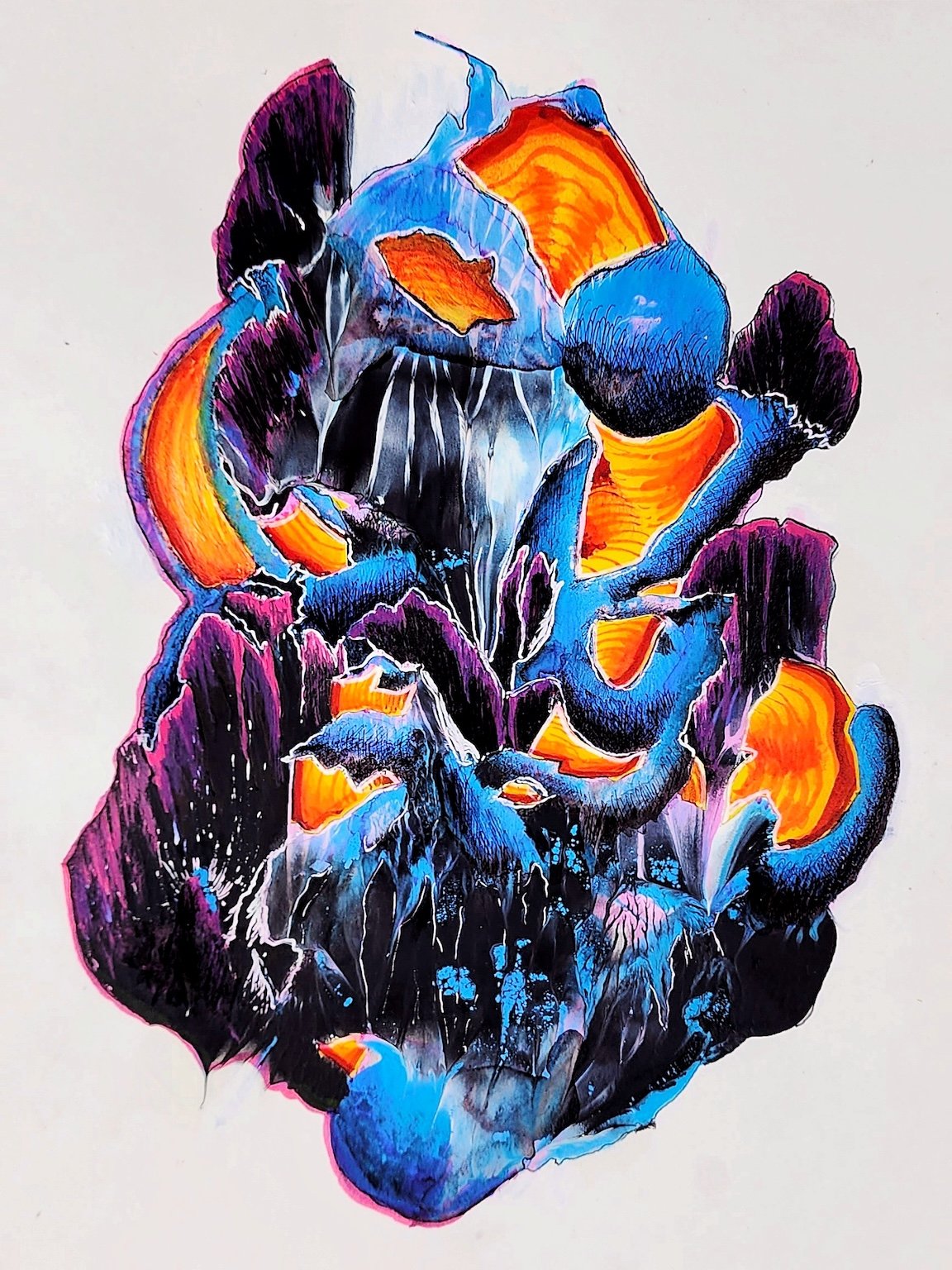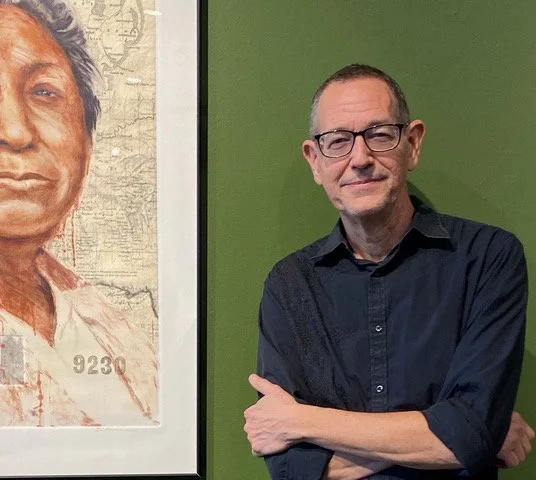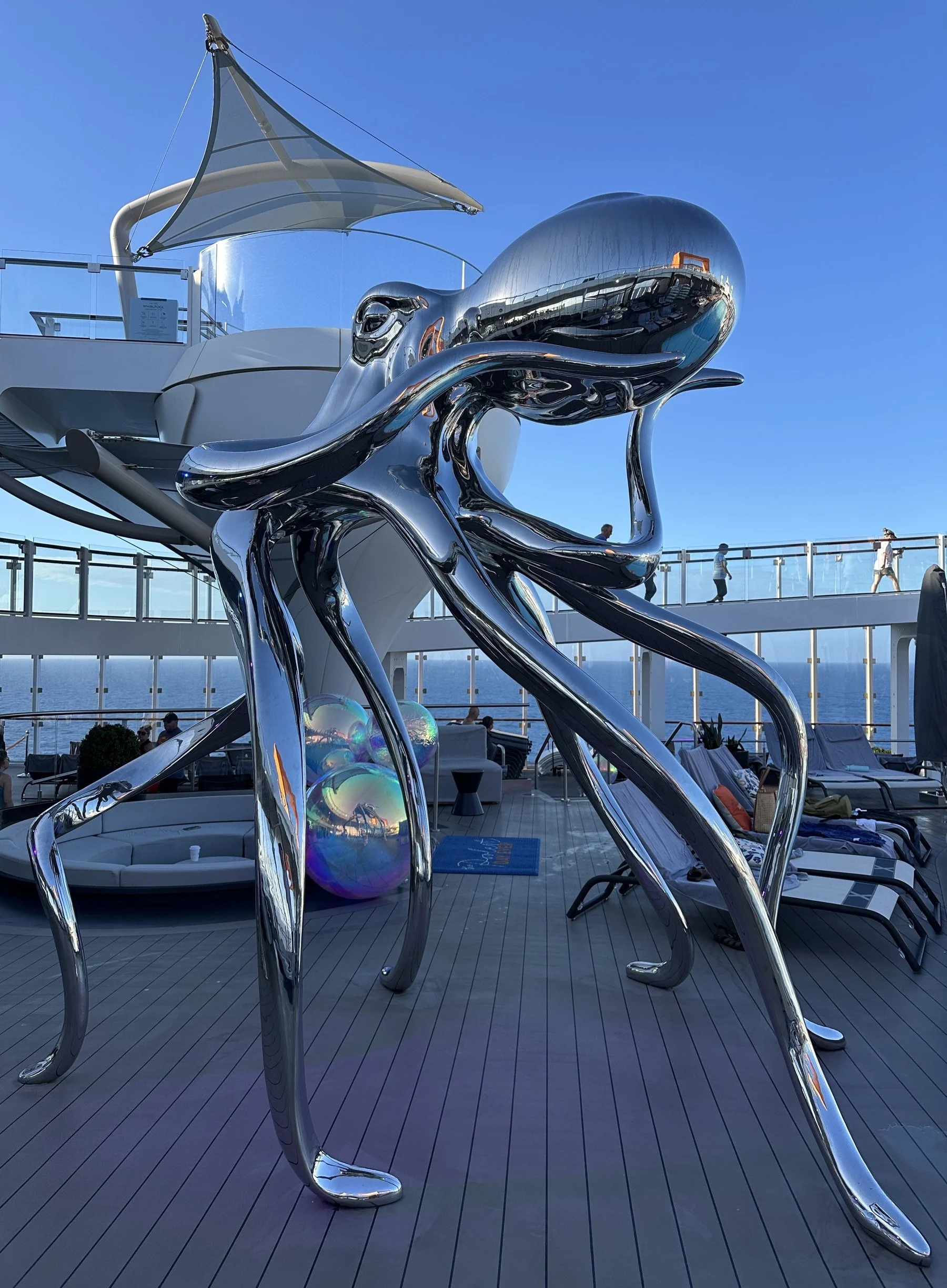Interview with artist Alexia Lams
Alexia Lams is a multi-media artist from Monticello, Arkansas. She earned a BA in art from the University of Arkansas Monticello and is currently working toward an MEd degree. Her paintings, filled with energy and electric with color, have been featured in Small Works on Paper traveling exhibitions and in juried shows in Louisiana, Indiana and throughout Arkansas. More of Alexia’s work can be found at her Facebook.



AAS: Alexia, tell be about yourself. Did you grow up in Arkansas?
AL: I was born in Pine Bluff, Arkansas in 2001. I’m the youngest of three children. I grew up in an area called Tarry which is a neighborhood along highway 425. It was weird because half sat in Lincoln County and the other half in Jefferson County. It was one of those neighborhoods along the highway where there isn’t a two-story anything, just a cluster of white-flight homes with patchy grass yards, riddled with dirt roads that would either be a short-cut to your cousin’s house or a run-down trailer with too many dogs and confederate flags waving you down. It was a nice little patch of area populated with towering trees. Very different from the miles of flat farmland that welcome you from either side of the highway.
According to my mom, one day I somehow teleported when I could barely walk and waved to her from the middle of the highway (you see where I get my imagination from). You can imagine how many times we got to play outside after that. So, a good amount of my childhood was spent in my room, looking out the window at the towering trees imagining myself interacting with that world. I developed a habit from doing that, always looking off somewhere imagining what it’d be like if I were somewhere else.
I attended Star City School district the entirety of my K-12 schooling. Unfortunately, I was a part of the 2020 (Covid) graduating class. During quarantine, I remember wanting to go to a college that felt like my high school as a way of gaining back the time I’d lost. Last year I graduated from the University of Arkansas at Monticello with a BA and I am now working on my MEd there.
AAS: Growing up, did you think of yourself as an artistic kid?
AL: I remember being a very shy kid. I was very cautious with people, and this made me very hesitant to express myself directly. I always felt “stranded”. I was always finding new ways to immerse myself. It was the early to mid-2000’s so the lava lamps and Windows XP visuals were my way of escaping my environment.
My first introduction to art was when I was probably between the ages of 3 to 5 when my grandma had this painting resting on an easel at the rear of her home. It was a landscape with tall palm trees and shallow waters. I remember standing in front of it sort of “painting” myself into that scene. I remember imagining the air being humid and still.
I think I was also very intuitive. I understood the power of language, but I was cautious about talking, I just didn’t want to waste words. This caused concern in pre-school, and I was often taken to a separate classroom to do art projects. That’s when I began to find art as comfort. I became known as the “art girl”. Art gave me an excuse not to talk. People often think that talking to an artist while they’re creating art is rude, so I used art as a way to avoid conversations. Great gig.
AAS: Congratulations on the success of your senior exhibition last year. Tell me about it.
AL: Thank you! My senior show Mercurial: Rhyme and Reason was a compilation of work I’d explored over a 10-month period with a few significant pieces I’d made earlier. Acrylics, oils, watercolor, spray paint, marker, ink, earthenware, ceramic glazes were used throughout the exhibition.
There were a total of 39 pieces in the show, including 4 ceramic vessels. Although I claim the title “painter” I love to explore with different mediums to feed my creative hunger without exhausting or boring my muse. My ceramic works are a great example of my exploration. I can admit, I fell into a “glaze craze” my senior year. I like “run” and “crawl” glazes.







AAS: I want to ask you about your mixed media abstracts, which are quite different from your figurative work. Spirit Animal is one of my favorites. What fuels your abstract style?
Spirit Animal, acrylic, marker, ink on paper, 11” x 8.5”
AL: Spirit Animal was one of the first abstract “mercurial” pieces I’d done. It was part of an exercise/experiment – cutting out negative space within a painting and adhering a piece of colored cardstock to the back, giving it a consistent solid color to compliment the subject. These were tiny “kitchen sink” pieces that allowed me to experiment with multiple process at once (cutting, light, shadow, values, line, mass, color). I understood with these pieces that they reflected my subconscious. Anything could pop up/appear in the images. That was the case with Spirit Animal. After sitting with the piece for a bit I recognized a cat lying in a rather provocative way. Even more interesting, the shape of the feline’s body is very similar to mine. The body is curvy, with the transition from small legs to swollen thighs that take an obvious dip in the hips. The torso then curves upward to this feline facial structure with long skinny ears. She interacts with a figure that lays leisurely above her as if resting on “his” elbow. This was the first time I experienced erotic tones in my work. I was convinced that perhaps my Spirit Animal appeared in this piece symbolizing my transition into womanhood – the feminine prowess I tried to cloak by wearing oversized hoodies and shirts.
AAS: Your paintings explode with color. Is color in some way comforting to you?
Sweet Mercury, acrylic, spray acrylic, marker, ink on paper, 11” x 8.5”
AL: My relationship with color is strange, but I feel common. I was probably a sophomore in college when I realized how much I rely on color. I use it in math, memory, and sight. I have difficulty observing things in relation to space so rely on color to determine when something ends/begins. More specifically, there are some colors that provide comfort. For example, as you flip through my works, you’ll see a vast majority of my paintings feature this turquoise or near turquoise color. I use this color to refer to the innocence of my psyche. With Sweet Mercury I pay tribute to my former professor and mentor, Tom Richard. I care for Tom as if he was my own dad, drawing out an innocence within me that a daughter could have for her father. For context, I come from a fatherless home, so those places of void are cavities caused by abandonment, disappointment, longing, pain caused by not having my dad around. The innocence depicted by the illuminated turquoise (a color meant to cleanse, heal, and calm) interrupted by moments of black (void) reflect both love and loss. The pink Sweet Mercury color palette is an obvious homage to Tom’s Bubble Gum art. The composition of the mercury alludes to the constant movement of time, like sand in an hourglass. I don’t know how much time I have left with Tom, so with this piece I tried to not only express my sincere gratitude for his role in my life, but also the overwhelming anxiety of knowing our lives are finite. The juxtaposition of “sweet” and “mercury” further supports the turmoil of my father-daughter relationship that it is both sweet and innocent like bubble gum.




AAS: When you think back over the time you spent preparing for your exhibition and learning about creating and learning about yourself, what were some of your aha moments?
AL: Oh man there were so many. I remember going “aha” when Tom, my professor, informed me that my smaller, earlier abstract work were derived from Rorschach tests. By applying a careful design of paint on one sheet of cardstock, I’d press another sheet on top producing two reflective images. It made sense that those works evoked more conversations about my subconscious than any of my other paintings.
Through exploring different mediums, I found that I prefer quick, easily accessible mediums like acrylics. This allows me to take advantage of fleeting moments of creativity while also infusing energy into my work. Personally, I can get too “fussy” with oils because there is enough time to manipulate what has already been done. I prefer a medium that’s less forgiving (acrylic, watercolor, ceramic glazes).
AAS: You’ve had pieces in both the 2024 and 2025 Small Works on Paper. What it is like seeing your work hanging alongside so many fine artists?
AL: Seeing my work displayed among the creative artists here in Arkansas feels like I’m looking at a quilt with my name stitched in one of the squares. We are all woven together by a drive to create. It’s so rewarding.
AAS: Your painting Good Days was featured on the cover of the 2025 SWOP brochure catalog. That must have been exciting when you learned that it would be featured. Tell me about that painting.
Good Day, acrylic and ink on newspaper, 14” x 11”
AL: That was very exciting! I was smiling ear to ear. Good Days was an attempt at fusing both worlds (mercurial and representational) together. I did this by walking around campus, taking photos of places that I found inspiring. On this walk, my good friend Brian (the guy in the painting) was with me. We visited the university botanical garden in hopes of finding a plant or flower that caught my eye. I remember seeing the grass spring beneath his feet, nearly swallowing him whole. The summer sun shined down on him. I found it to be so beautiful. I captured the moment on my camera and that’s how the representational part came to be.
The mercurial elements are spontaneous additions to the scene that reflect my need for guidance. The luminescent balls of light that are meant to mimic will-o’-the ‘wisps (based on Scottish-folklore of pulsing balls of light guiding travelers through bogs, swaps, pathways, etc during the night) dance around him as if to guide him through a bog. The big red bulbous forms suspended in the air symbolize the presence of my subconscious. I added these elements to the painting to reflect my state of mind as I made the piece. I was uncertain about where to go next in my career. I felt lost. These orbs appear in my reality as a way of saying “we’ll guide you”.
AAS: Source of Light is an enigmatic image. Who is the person in the painting and what is its story?
Source of Light, acrylic and ink on newspaper, 14” x 11”
AL: Source of Light is a painting of my friend Eduardo. We first met right around the time I got my first “big girl” job on campus. I associate our friendship with a new chapter in my life. A new beginning. This transition between childhood and adulthood. As a child, you aren’t in charge of your life just yet. As an adult, no matter what you’ve gone through or what’s happening in the world, you are accountable for who you become. During this period of trying to make something of myself, I met Eduardo. I regard him as the person I aspire to be. He embodies the Sagittarian spirit. Constantly moving, running, flying, soaring. However, my life is so weighed down by my own fears and obligations. I pin back my own wings.
I titled this piece Source of Light because Eduardo represents hope. He’s always encouraging me to push through the void. He’s a reflection of an unbound future. A promise of unprecedented exploration and flight.
AAS: One of your most recent paintings, If Only, is a wonderfully expressive portrait of hope and longing. What is the story behind it.
If Only, acrylic, marker, ink on paper, 10.5” x 9”
AL: If Only is a piece inspired by a song my brother wrote with the same name. I’ve always loved the song because in the hook he pleads to God for guidance and freedom singing:
Times are getting harder, father
I don’t want to be a bother, father
I just thought I oughta tell ya’
If Only I had my ways
Out of here….
We grew up in poverty. Therefore, we survived in a world built from broken dreams. As a young man with a dream, I hear the desperation, the fear, the hunger in my brother’s voice as he begs God for guidance. I resonate with his plea as an artist. With everything I create I silently whisper “If Only”.
AAS: Alexia, where to you see yourself and your art practice five years from now?
AL: I still see myself in Arkansas. I feel like there is a rich art culture here that needs to be explored. I see myself enriching art education here at UAM. I’m pursuing a master’s in education now because I strongly believe our curriculum in Southeast Arkansas is unaware of how to nurture the emerging artist. I want to know how our education system is constructed and why in a world created so plentiful must the creative starve.
At this point in time, I feel comfortable with someday teaching art to college students. I really want to help students succeed in the art world. I fear that many college art students, like me, learn to appreciate art too late. I hate watching former classmates give up on their passion because the world doesn’t deem it a “real” job.


